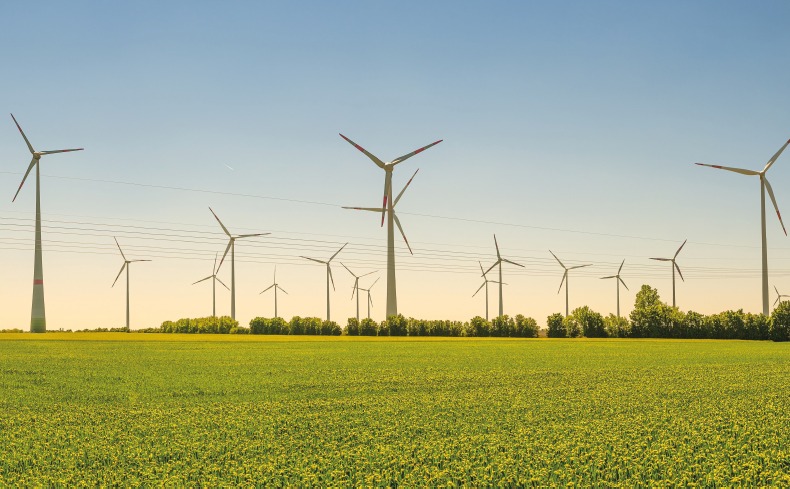Industry News15.09.2023
The south of Kazakhstan is overgrown with renewable sources

Vadim Kulik, Director of Zhanatas WPP for business development

These regions of the country have great potential for implementation of major projects
Kazakhstan has a significant potential for renewable energy sources, and this attracts international companies to implement large-scale projects here. For example, the French Total Eren, together with KazMunayGas and the Samruk-Kazyna Fund, have agreed to build a 1-gigawatt wind farm, there are similar plans in partnership with ACWA Power from Saudi Arabia.
There are indeed opportunities for the implementation of such projects. Thus, the Samruk -Energo's “review of the renewable energy market in the Republic of Kazakhstan” specifies that wind speed is 4-5 meters per second at an altitude of 30 meters on about half of the country's territory.
The highest wind potential is available in the Caspian Sea region – in Atyrau and Mangistau regions, as well as in Northern and Southern Kazakhstan. In total, according to the Concept of Development of fuel and energy complex of Kazakhstan until 2030, the wind potential of Kazakhstan is more than 1 trillion 820 billion kilowatt-hours per year.
Similarly, there is great potential in solar energy. it also has significant potential. The Concept for development fuel and energy sector states that its potential is about 2.5 billion kilowatt–hours per year, since 2.2 to 3 thousand solar hours are observed on the territory of the country for 12 months.
In addition, in terms of absolute indicators of potential hydro resources, Kazakhstan ranks third among the post-Soviet countries. Experts estimate the hydropower potential of our country at about 170 billion kilowatt-hours per year, and technically feasible – at 62 billion.
Hydro resources are distributed throughout the country, but among them it is worth noting three areas, including the Irtysh basin with the main tributaries, the Southeastern zone with the Ili basin and the southern zone as part of the Syrdarya, Talas and Chu river basins.
Leaders go to Kazakhstan
It is the country's considerable potential and ambitious decarbonization plans that attract international investors. For example, the State Power Investment Corporation plans to build several enterprises in our country for production of components for wind farms. We can talk about the production of towers, gondolas and blades for “wind turbines”.
Moreover, with another Chinese company – SANY Renewable Energy – a wind park with a capacity of 1 gigawatt will be built in Zhambyl region, and this will immediately increase the total power generation capacity from renewable sources in Kazakhstan by 40%. According to media reports, an energy storage facility will be built next to the wind farm park, which will smooth out fluctuations in wind generation when weather conditions change.
In addition, we can note the above-mentioned project of Total Eren, KazMunayGas and Samruk-Kazyna for construction of a wind farm in Mirny settlement, Zhambyl region, with a capacity of 1 gigawatt and a cost of $ 1.9 billion. The power plant is planned to be launched in 2026-2027. The plant will also use an electricity storage system to make the energy supply to the system more stable. Another large-scale project is planned to be implemented with Saudi ACWA Power - also for 1 gigawatt.
All these projects together will help Kazakhstan cope with the shortage of electricity and, at the same time, make the energy system more “green”.
The latter is relevant for the economy of Kazakhstan, especially exports. For example, the European Union accounts for about 40% of our country's total foreign trade turnover, and carbon regulation is being tightened there.
Soon, the goods of companies with a high “carbon footprint” (i.e. large emissions during production) will be subject to new import duties, which will affect their competitiveness in the European market.
EY writes that according to the World Bank, after the introduction of carbon regulation by the European Union in 2026, Kazakh exporters may lose up to $ 250 million in revenue annually with metallurgy sector most affected.
That is why it is more important for Kazakhstan to develop renewable energy than ever before – because it offers clean energy to businesses. Meanwhile, 130 renewable energy stations with a total capacity of 2.4 gigawatts are already operating in the country. If we specify by type of sources, these are 44 solar stations with a capacity of 1,148 megawatts, 46 wind stations with a capacity of 958 megawatts, 37 mini-hydroelectric plants with a capacity of 280 megawatts and three bioelectric power plants with a capacity of 1.77 megawatts.
At the same time, during 2023, according to media reports, it is planned to put into operation 15 more renewable energy facilities with a total capacity of 276 megawatts.
Concentration in the South
Almost all future giant renewable energy projects are planned to be implemented in the southern regions of Kazakhstan, and this is no coincidence – there are large wind and solar resources here. The attractiveness of these regions is confirmed by the fact that several renewable power plants have already been built and are operating here.
One of them is Zhanatass wind farm in Sarysu area of Zhambyl region. Its capacity is 100 megawatts, and it covers the energy needs not only of this area, but also of several nearby settlements.
This project was implemented by Visor International DMCC with Kazakh roots and China China Power International Holding Limited. They invested about $ 130 million in the construction of station, and now a station of 40 wind turbines with a capacity of 2.5 megawatts each is operating near the city of Zhanatas in southern Kazakhstan.
“The station was built in an open field from scratch – this is one of the first such large projects in Kazakhstan with a capacity of 100 megawatts. Currently, the construction of second stage of the wind farm for another 100 megawatts is underway,” Vadim Kulik, Director of Power Plant for Business Development, said on the sidelines of the international business festival of renewable energy “QAZAQ GREEN FEST 2023”.
It is worth noting that the first stage of Zhanatas WPP has been operating for the second year, and about 360 million kilowatt-hours of energy is provided in the network of KEGOC operator.
At the time of commissioning, it was the largest wind power plant in Central Asia. It was possible to implement such a project, among other things, thanks to the installation of the most modern turbines at that time: while turbines with a capacity of about 1 megawatt were installed at most wind farms, 2.5 megawatt turbines were used here.
According to Vadim Kulik, even more modern wind turbines are used – already at 4.5 megawatts during the implementation of second stage. According to him, this will allow reducing the area of the entire station, while maintaining power.
In general, this project solves an important problem for Zhambyl region – stability of supply of electricity in rural areas. At the same time, local mining enterprises that have received a reliable source of clean energy benefit.
According to open sources, the power plant provides social assistance to the region. An ambulance was donated to the Central Hospital of Zhanatas, the roof of a residential building was repaired and five apartments were repaired, and Yntymak alley was landscaped.
Kazakhstan and UAE reaffirm strategic energy partnership with 1 GW wind project
Solar becomes EU’s top power source for the first time ever
How decentralised renewables transform healthcare services in rural Zimbabwe
Chinese company to build solar and wind power plants in Kyrgyzstan
Seaturns raises €2.45 million to industrialize wave energy technology and accelerate global rollout
Trump signs executive order to end subsidies for wind and solar energy
Uzbekistan's solar and wind power plants generate 5 Billion kWh since beginning of the year
Green Corridor Alliance JV registered in Baku to promote green energy development in Central Asia and the South Caucasus
In the EU renewable energy supply grew by 3.4% in 2024
IRENA accepting renewable energy project proposals in Central Asia until August 15
Astana to host Electronica Expo Kazakhstan Electronics Exhibition
WB gives rundown of Azerbaijan's green energy grid volume prospects
US solar sets new records as renewables nearly match natural gas – EIA
‘Wings’ on poles: Bill Gates-backed breakthrough wind turbine facility breaks ground
Perovskite tandem solar cell achieves new efficiency record
Kazakhstan and China endorse draft SCO joint statement on sustainable energy development
Innovative research on organic solar cells for space applications
Kazakhstan and Uzbekistan drive green energy progress in Central Asia
KazMunayGas launches pilot green hydrogen project in Atyrau
How private homeowners in Kazakhstan can make money from solar panels











